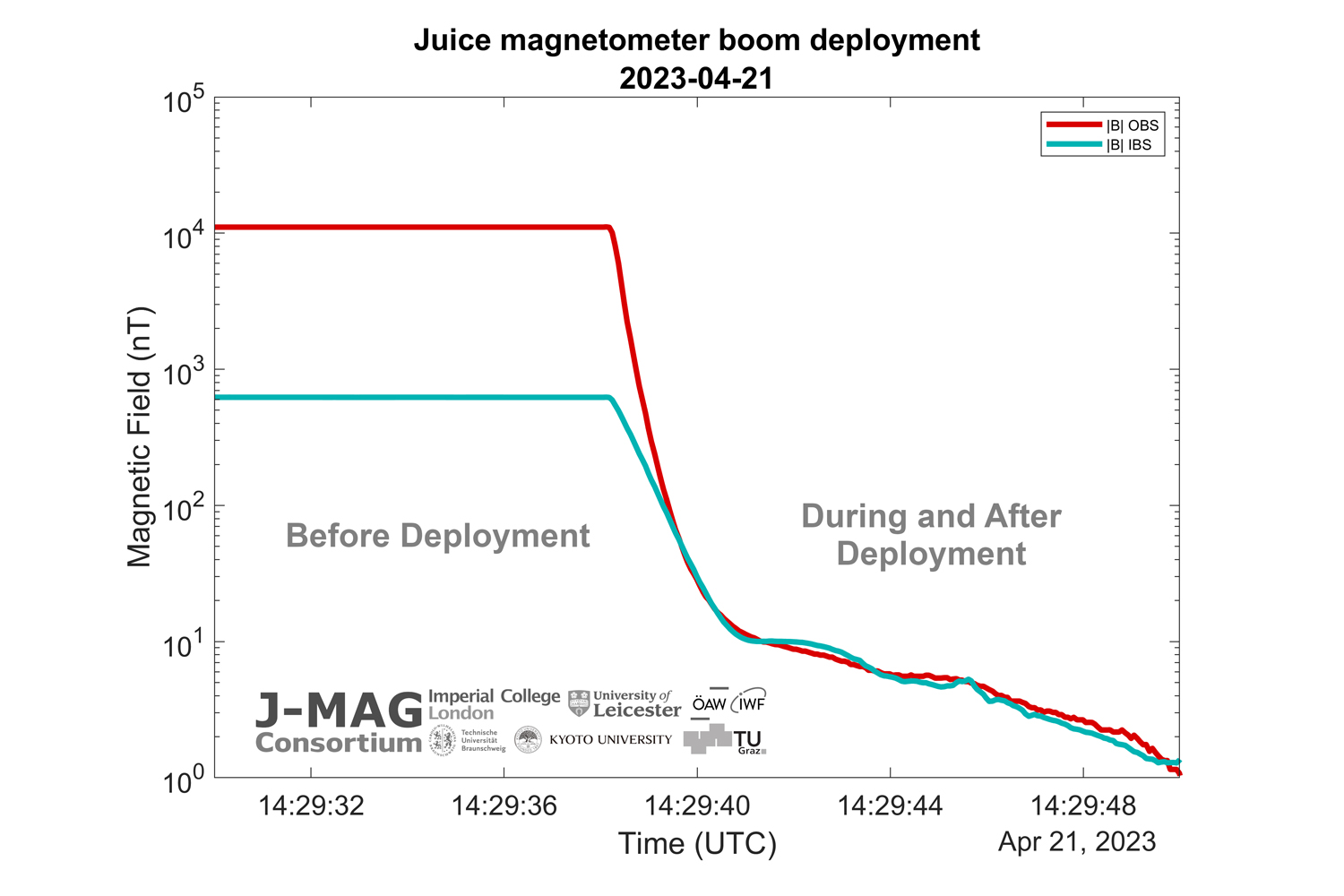Jupiter mission: Boom successfully deployed Sensor from TU Braunschweig as part of the instrument package begins its work
One week after launch, the boom on which the magnetometer instrument is installed on the JUICE spacecraft was successfully deployed. The magnetometer instrument, J-MAG for short, which has now begun its work, consists of several sensors. One of the sensors was developed at Technische Universität Braunschweig. Folding out the boom is a prerequisite for the correct recording of magnetic field data. Only in this way can the smallest magnetic fields be observed, which originate from oceans beneath the lunar surfaces. J-MAG thus allows an insight into the interior of Jupiter’s moons.
JUICE was launched on 14 April 2023 on an Ariane 5 launcher from the European Spaceport in Kourou, French Guiana. A week later, on 21 April, the 10.6-metre boom was deployed and the J-MAG magnetometer instrument was switched on. The data collected by J-MAG captured the moment of deployment.
The J-MAG instrument will be crucial for the JUICE mission to characterise the oceans suspected to lie beneath the outer ice crusts of three of Jupiter’s moons – Ganymede, Callisto and Europa – and to determine whether they could harbour life.
Although JUICE will take about eight years to reach the Jupiter system, the early deployment of the instrument is an important milestone for the feasibility of the mission.
Michele Dougherty, Professor of Space Physics at Imperial College London, is leading the J-MAG project: “It was a great relief to see the successful deployment of the magnetometer boom, which was the crucial next step for the team.”
J-MAG consists of three sensors built at TU Braunschweig, Imperial College London and the Graz Institute for Space Research of the Austrian Academy of Sciences in collaboration with Graz University of Technology, Austria.
The two instruments at Imperial College London and TU Braunschweig are “fluxgate” sensors that can measure the direction and strength of magnetic fields. They are designated as “outboard” (MAGOBS) and “inboard” (MAGIBS, TU Braunschweig) sensors, respectively, spaced about three metres apart, with MAGOBS mounted near the end of the boom.
Plot of the magnetic field data shows the instrument mast unfolded
A diagram shows the strength of the magnetic field from the two fluxgate sensors MAGOBS and MAGIBS before and after the mast was unfolded. The left side of the diagram shows the measurement of the local magnetic field traces before the boom deployment. The sensors are mounted on the side of the spacecraft and MAGOBS is close to two of the spacecraft’s thrusters, which are very magnetic, explaining the large discrepancy in the two field strengths between MAGOBS and MAGIBS.

Plot: The image shows the strength of the magnetic field of the two fluxgate sensors on the boom before and after deployment. Image credit: ESA/Juice/J-MAG consortium
On the right, the curves change when the boom is deployed, which takes about two seconds. The two field strengths are then at a similar level close to zero and are stable. This indicates that the boom could be fully deployed and both sensors are measuring the ambient solar wind field, which is very small – in the range of a few nanoTesla (nT).
To fully calibrate the J-MAG instrument, the third sensor, MAGSCA, which measures magnetic field strength, needs to be turned on, which will be done in the coming week.
TU Braunschweig also involved in ESA mission with camera data processing unit
In addition to the Institute of Geophysics and Extraterrestrial Physics at TU Braunschweig, the Institute of Computer and Network Engineering is also involved in the Jupiter mission. Under the direction of Professor Harald Michalik, a data processing unit for the JANUS camera was built here. The camera is used to characterise the surfaces of Jupiter’s moons Ganymede, Callisto and Europa in order to study their geological activity. The task of the data processing unit is to control the camera electronics and to compress the image data in real time before the images are copied into the data storage of the JUICE spacecraft and sent from there to Earth at a low data rate.
About the JUICE mission
In 2030, the JUICE orbiter will arrive in the Jupiter system. A three-and-a-half-year investigation period will then begin. The structure, composition and dynamics of Jupiter’s atmosphere will then be studied. This will be followed by fly-bys of Jupiter’s moon Europa, focusing on geology and composition. Furthermore, the inner structure, the surface and the outermost layer of the atmosphere of the moon Callisto will be studied in detail. The final phase of the European Space Agency (ESA) mission is dedicated to Ganymede. For this, the orbiter will enter a stationary orbit around the moon. In this final phase, magnetic field observations have particularly high priority, as they can provide valuable information about the interior of the moon. The goal is to determine the depth and extent of the suspected ocean and to understand the source of Ganymede’s own field and its interaction with Jupiter’s magnetic field.
